Introduction

Gentlemen. As you know, We are on the cusp of the greatest test of our capabilities. The Fuhrer has ordered the invasion of the Soviet Union – codenamed Operation Barbarossa – to begin today.
While the first usable reports from the front will not be in for a few days yet, This briefing has been prepared to give you an overview of the preparations that we have undertaken for this mammoth operation.
Firstly, we should look at the balance of forces.

The first number is the TOE (Table of Equipment) value – or what we should have, the second number the actual numbers in the field.
On paper, and including our allies, we have the numerical advantage in troops, with the enemy having the advantage in tanks and planes. This is not the real picture however. Most of the Russian tanks are obsolete, their tactics are almost non existent, and we will have the advantage of size.
Also, our allies are not to be trusted. While our troops are battle hardened from their actions in Poland and France, our allies are as green as the grass, and their devotion to the cause is suspect. We are also expecting the Russians to massively mobilize in the first few weeks of the war.
Encircling and capturing as many Russians as possible will be the key to our success – while taking ground is important, the destruction of the Soviet armies should be the priority. We need to also destroy their industry as quickly as possible.
Now let us look at the main map, before going over the front in detail.
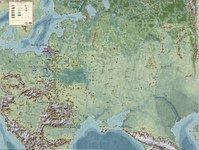
Click here for the full 3000x2266 image
As you can see, we have divided our forces into three army groups, splitting the invasion of the country into three sections. Each of these army groups has been given a major Soviet city as a target.
I have helpfully colour coded the markings on the map to match the colours being used to not the various armies. This map also shows the whole of the front, something that will not be shown often now, as no one needs to see large amounts of empty territory.


Click here for the full 1428x1036 image
Army Group North is made up of two infantry armies and the 4th Panzer Group. Their target is the traditional capital of Russia, St Petersburg. This of course is currently named Leningrad, after the Communist leader.
Their advance has the fewest Russian troops, and the closest city to our current borders, but they also have to traverse the worst terrain. The whole north of the Soviet Union is covered in marshland. This will slow the rate of advance, and may well give the Russians time to fortify the city. As such, this is the plan is as follows.

The first step is to secure a crossing over the Daugava, most likely taking Riga to capture the port there. Then we will head towards Pskov before heading east of Leningrad to cut the supplies to the city before cleaning it up.
Once Leningrad has been secured, we shall turn south and threaten Moscow from the north.


Click here for the full 1751x679 image
Army Group Centre has the bulk of our forces, three infantry armies and two Panzer groups. Their target is the main prize – Moscow. They have a large number of enemy troops before them, and are sure to run into the bulk of the fresh reinforcements. The Pripett Marshes mark the southern edge of their area of operations.

The Two panzer formations will make a pincer movements from north and south to trap the bulk of the Russian forces, before striking towards Moscow. While this is not the most cunning on plans, it will be effectively brutal, and should deliver the Russian Army a death blow that they will be unable to recover from.


Click here for the full 1593x1042 image
With three German infantry armies, one Panzer group, and two Romanian armies, Army Group South. Seems to have the largest troop concentrations, but the Romanian armies will not move until it has been proven to their leaders that we can advance deep into the enemy territory and will not meet much resistance.
While Sevastopol is their ultimate target, the seizure of Kiev is also important to us, as it will allow us to cross the Desna. If this major river is fortified, it could blunt our advance.

We shall begin by making a pocket around the enemy concentrations at Lvov. Then when the Romanians get into gear, we shall take Kiev and then drive south. Sevastopol will be abandoned if the troops are needed elsewhere.
Here is a map showing the front lines. This will be updated, showing our advance as time goes on.
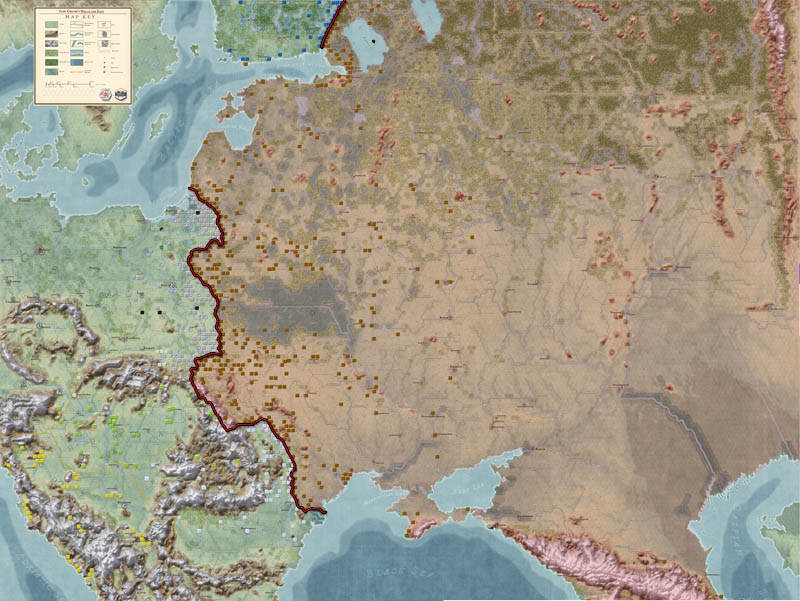
All along the line, the Luftwaffe is ready to bomb the enemy airfields, the plan is to knock the Red air force out before they can even get into the air.

Right, so while there is no actual fighting here, I thought I'd use this update to go over the game itself. Lets start by going over the basics.
As you can guess, its a hex based wargame, with each turn after the first two covering one week. The first two turns cover four days to represent the speed of the opening phases of the war.
The hexes each represent ten miles of terrain, and is mainly a divisional scale operation game, although units can be broken down into brigades. Supplies are modeled, as are units down to the squad and plane. As you may have guessed from the title, this is the sister game to War in the Pacific, and is by the same company. As with most of my games, it is available solely through Matrix games, for a price that makes most people weep. (Insert normal rant about the overpricing of grognard games here)

Rather than assume you can all read NATO symbols, here is the bulk of the units we will be meeting. They are all nicely labelled by the game.
The Security division is used to clean up partisans, the fortified zones are not much of a threat on their own, but can be used to quickly build fortifications up.
The black units represent SS units, grey German, brown Russian and red will be the Guards units, when they start appearing.
Romanian units are white, Hungarians green and Italians yellow (no comment).
Above the NATO icon is a number of X's – one means brigade size, two division, three corps and four army. The units name appears at the top, with its parent unit above that.
Below the NATO symbol are two number (13-50) the first is the combat value of the unit (CV) the second is the number of movement points it has. Below this is a number showing what percentage of these the unit has remaining.
To the left of the box is the percentage of supplies the unit has, from top to bottom showing supplies, fuel and ammunition. As you can see, at this point, everyone is well stocked ready for action.
Now lets take a look at one of these units in more detail.

As you can see, the 3rd Panzer Division is very experienced, well rested, has all of the units it is supposed to (the TOE) and has good morale. Its made up of a large number of different unit types, but the most interesting for you guys will be the tanks – mostly Panzer MKIII's, with a large number of MKII's still around.

This is the 3rd Panzer Divisions HQ unit, the XXIV Panzer Corps. Units need to stay within a certain distance of parent unit to receive resupply, so a Panzer unit driving off into open terrain can soon find itself without supplies.
HQ Unit cannot fight, and if they are in a hex next to a enemy unit without a combat unit, they will displace towards the rear, allowing the enemy to capture all of the supplies that they had stockpiled.
You can also see the attached units – these are small but powerful units that are not modeled on the map, but rather attached to other units as modifiers – if attached to a HQ unit like this, then they will be applied as the AI sees need.
We also have leaders for each unit, which affects the skills of all unit under that mans command. So lets have a look at the man in charge of O.K.H. At this time.
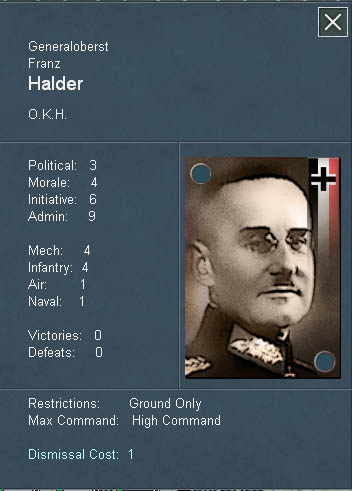
Oh dear. General Halder is not the most stunning of protegees is he? He's a good administrator, but that's about it. All these values range from one to ten. Luckily, we have something called action points. We get fifty of these a turn, and start the game with 30. Halder will cost us only one to get rid of.

Von Kluge takes command, while he is no better at mechanized command, he is a much better all rounder in the non command sections, which is more important for a high level commander. Also note that victories and defeats are tracked for each General, and Hitler may well remove Generals from office without my say so – he's a gem for doing things like that.
There is no naval combat (so no Battleships to lose), and air combat is simplified.
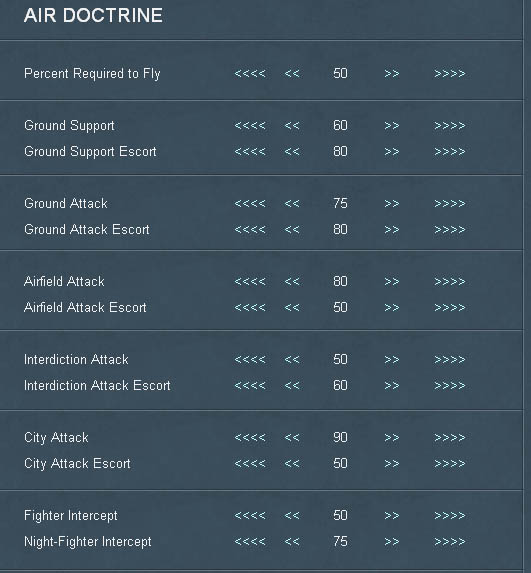
This is the air screen, as you can see, its fairly simple.
Lets have a look at production.
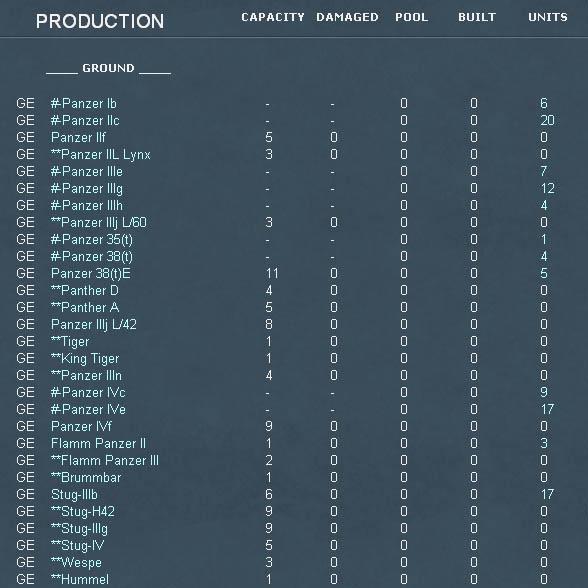
Well, its a list of numbers, as you'd expect. It does tell us some useful things, like there are six units still using the Panzer MKI, of which we are producing none of, and have no spares remaining. In fact. We have no spares of ANYTHING. Hopefully this will change.
For those of you about to say “Wait! You get Tigers in 1941?!” you can get more information on a unit by clicking on it.
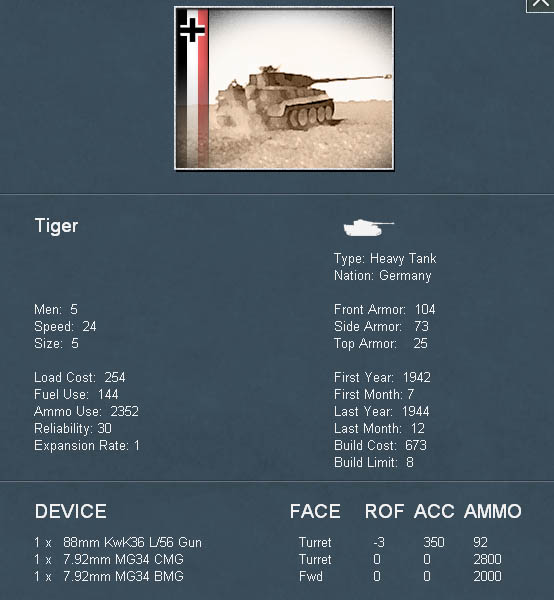
So although its on the list, I won't see any until July 1942, and will see my last one in December 1944. I also get some scary amounts of data. Their not that fuel efficient, hard to transport, use a lot of ammo and are not that reliable – that sounds like a German heavy tank to me. But now I'm going to put this away for a year. What we have now are these.

And lots and lots of these guys.

Also on the production tab is this.

Boring I know, but the lifeblood of our forces. Yes I have an excel sheet to track these things. There will be graphs.
The last thing I'm going to mention that that I will not be playing with random weather on. The current version has this bugged so you can have a mud turn in July, while I'm all for moving the start of winter by a few weeks in either direction, totally random weather is no fun, so its being left off.
I will go over the combat mechanics when I'm actually shooting at things, so now you have to wait four days for the next turn. See you then.
Please, no attempts to discuss war crimes in here. Neither side in this war were very nice people, and this is a game, not an attempt to replay history.
Table of Contents
- Chapter 1
- Chapter 2
- Chapter 3
- Chapter 4
- Chapter 5
- Chapter 6
- Chapter 7
- Chapter 8
- Chapter 9
- Chapter 10
- Chapter 11
- Chapter 12
- Chapter 13
- Chapter 14
- Chapter 15
- Chapter 16
- Chapter 17
- Chapter 18
- Chapter 19
- Chapter 20
- Chapter 21
- Chapter 22
- Chapter 23
- Chapter 24
- Chapter 25
- Chapter 26
- Chapter 27
- Chapter 28
- Chapter 29
- Chapter 30
- Chapter 31
- Chapter 32
- Chapter 33
- Chapter 34
- Chapter 35
- Chapter 36
- Chapter 37
- Chapter 38
- Chapter 39
- Chapter 40
- Chapter 41
- Chapter 42
- Chapter 43
- Chapter 44
- Chapter 45
- Chapter 46
- Chapter 47
- Chapter 48
- Chapter 49
- Chapter 50
- Chapter 51
- Chapter 52
- Chapter 53
- Chapter 54
- Chapter 55
- Chapter 56
- Chapter 57
- Chapter 58
- Chapter 59
- Chapter 60
- Chapter 61
- Chapter 62
- Chapter 63
- Chapter 64
- Chapter 65
- Chapter 66
- Chapter 67
- Chapter 68
- Chapter 69
- Chapter 70
- Chapter 71
- Chapter 72
- Chapter 73
- Chapter 74
- Chapter 75
- Chapter 76
- Chapter 77
- Chapter 78
- Chapter 79
- Chapter 80
- Chapter 81
- Chapter 82
- Chapter 83
- Chapter 84
- Chapter 85
- Chapter 86
- Chapter 87
- Chapter 88
- Chapter 89
- Chapter 90
- Chapter 91
- Chapter 92
- Chapter 93
- Chapter 94
- Chapter 95
- Chapter 96
- Chapter 97
- Chapter 98
- Chapter 99
- Chapter 100
- Chapter 101
- Chapter 102
- Chapter 103
- Chapter 104
- Chapter 105
- Chapter 106
- Chapter 107
- Chapter 108